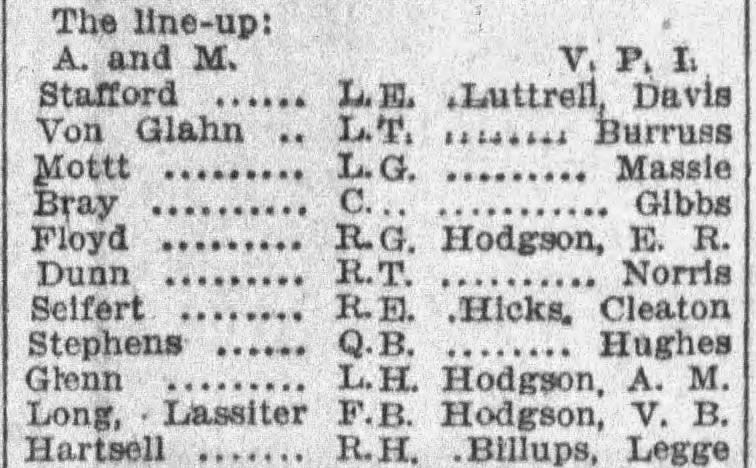Today's Tidbit... Helmet-Tossing Trickeration
In A History of the Football, I mention that stripes were added to footballs for two primary reasons. One was the desire to make the ball more visible under the poor lighting conditions of the 1920s and 1930s. The second reason was that teams wearing brown or white uniforms gained a camouflage advantage when playing with a plain brown or white ball.
There was another aspect of the camouflage issue of the late 1920s that a reader, Carter Claiborne, mentioned coming across in a game played two decades earlier. It arose in the 1909 Virginia Polytech-North Carolina State game played on Thanksgiving Day in Norfolk, which Virginia Tech won 18-5.
The 1909 Poly team had three Hodgson brothers in the lineup, but the most important one in this story was E. R., the team's right guard. He also handled the kicking and punting duties. Ol' E. R. was also the head trickeration man that day.
Virginia Poly took a 6-0 lead 12 minutes into the game when Vivian Hodgson had a short TD run, after which E. R. converted.
About five minutes later, the boys from Tech had the ball on the NC State 35 when E. R. dropped back to attempt a field goal as left end Luttrell positioned himself to hold. As the center snapped the ball, E. R. Hodgson removed his brown leather helmet and threw it over the right side of his offensive line, simulating a forward pass.
(The helmets and head harnesses of the day were much flimsier than those to come.) As E. R.'s helmet flew over the starboard side, Luttrell dashed around the left side of the line, taking it 35 yards across the goal line. There may have been earlier instances of the old fake-pass-or-fake-a-fumble-by-tossing-your-helmet trick, but the Hokies are the first to do so that I've heard of.
Their trickeration didn't stop there. Early in the second half, Poly had the ball on their own 35-yard line when E. R. Hodgson dropped back to punt once again. Rather than punt, he faked a pass and handed the ball to Hughes, the quarterback, on an early version of a draw or Statue of Liberty play. Hughes took it around the end for a 75-yard touchdown.

The fake pass and fake fumble trick became an issue in the late 1920s, leading the rule makers of 1930 to require helmets to have stripes of contrasting colors. Winged helmets and other schemes for painting the leather helmet straps ended the helmet toss trick, as did the onset of plastic helmets a decade later.
Football Archaeology is reader-supported. Click here to buy one of my books or otherwise support the site.




